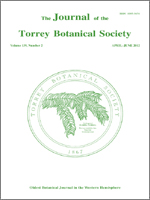Members of the aquatic plant genus Utricularia have extremely modified vegetative morphology, which includes absence of roots and lack of a clear distinction between leaves and stems. In this study, the vegetative morphology, anatomy and growth pattern of Utricularia gibba (L.), a common species in the southern Florida Everglades, was analyzed to determine general developmental patterns and establish a basic model for growth of this species. Specimens were collected from different habitats in southern Florida during both the wet and dry seasons. Light and scanning electron microscopy were used to quantify anatomical and morphological characteristics. Utricularia gibba has a shoot apical meristem that produces repeating developmental units, each of which consists of a stolon bearing dichotomously branched leaf-like structure that supports the traps. These structures may subtend one or more axillary buds that can grow out to form additional stolons or inflorescences. The inflorescence produces aerial flowers, but also forms a modified stolon at its base that is covered with unique glandular papillae. Re-iteration of this model through branching creates the floating and benthic mats found in this species. The basic model can be expanded to other species of section Utricularia but not to all species of the genus.
How to translate text using browser tools
1 April 2012
An architectural model for the bladderwort Utricularia gibba (Lentibulariaceae)
Theresa A. Chormanski,
Jennifer H. Richards
ACCESS THE FULL ARTICLE
carnivorous plants
Everglades
morphology
Utricularia gibba





